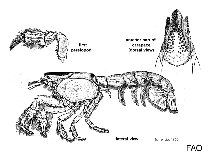Upogebia capensis (Krauss, 1843)
Cape mud shrimp
Upload your photos
Google image | No image available for this species;
drawing shows typical species in Upogebiidae.
Google image | No image available for this species;
drawing shows typical species in Upogebiidae.
Classification / Names Common names | Synonyms | CoL | ITIS | WoRMS
Malacostraca | Decapoda | Upogebiidae
Environment: milieu / climate zone / depth range / distribution range Ecology
Benthic. Subtropical; 26°S - 37°S, 16°E - 35°E (Ref. 4)
Distribution Countries | FAO areas | Ecosystems | Occurrences | Introductions
Southeast Atlantic and Western Indian Ocean: South Africa and Mozambique.
Length at first maturity / Size / Weight / Age
Maturity: Lm ? range ? - ? cmCommon length : 1.6 cm TL male/unsexed; (Ref. 4)
Short description Morphology
Rostrum ending in three teeth; the lateral teeth are placed at the end of a ridge that is separated from the central part of the dorsal surface of the rostrum by a deep groove. On the central part itself a very shallow median groove is present. There are no ventral teeth on the rostrum. The anterolateral border of the carapace with a single spine behind the eye. First pereiopods subchelate. Dactylus of adult male with a longitudinal groove on either lateral surface, and without a tooth on the cutting edge. Palm with 2 dorsal denticulate carinae. Merus without an anterodorsal spine. Coxae of first three pereiopods without spines (Ref. 4).
It has lengths of 1.5 to 1.6 cm, total body length; 2.7 to 6.5 cm, ovigerous females (Ref. 4). It burrows in sandy mud of estuaries form mid-tide to LWS [= Low water spring tide]. It is a detritus feeder (Ref. 4).
Life cycle and mating behavior Maturity | Reproduction | Spawning | Eggs | Fecundity | Larvae
Members of the order Decapoda are mostly gonochoric. Mating behavior: Precopulatory courtship ritual is common (through olfactory and tactile cues); usually indirect sperm transfer.
Main reference
References | Coordinator | Collaborators
Holthuis, L.B. 1991. (Ref. 4)
IUCN Red List Status (Ref. 130435)
CITES status (Ref. 108899)
Not Evaluated
CMS (Ref. 116361)
Not Evaluated
Threat to humans
Human uses
Bait: usually
| FishSource |
Tools
More information
Internet sources
BHL | BOLD Systems | CISTI | DiscoverLife | FAO(Publication : search) | Fishipedia | GenBank (genome, nucleotide) | GloBI | Gomexsi | Google Books | Google Scholar | Google | PubMed | Tree of Life | Wikipedia (Go, Search) | Zoological Record
Estimates based on models
Price category
(Ref. 80766):
Unknown.



